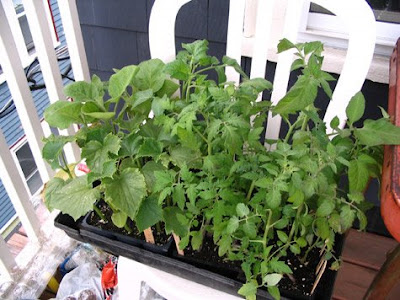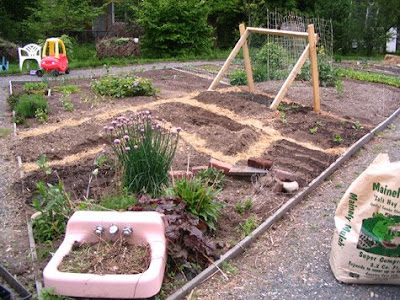
This Saturday I planted just about everything. It's a bit earlier than the dude where I picked up my seedlings suggested, but I feel certain that the plants have a better chance of surviving in the roomy, sunny and compost-ful environment of the garden than they would cramped in their seedling containers on my porch.
I had a fantastic time planting and am very excited to see how it all works out. It has turned colder in the past few days so I'm a bit worried about the cucumbers, but I think everything else should be able to handle it. Ah yes, I did have to get new cucumber plants at the farm, so it would be a shame to kill another set.
I also started the "summerizing" of my front porch with a few planted flowers and an overall clean up from the dirt and mess of the winter. Once again, you can see my cat in the photo if you look carefully. She loves the porch.

As part of all this prep however, I realized that as I've moved from a flat out beginner to a slightly more experienced novice, there are things that no longer shock me. One such example is the fact that I routinely (and gleefully) treat my seedlings to a diet of dead animal parts to help them grow.
Do vegetarians know about this? What about Jews who keep Kosher?
What the best organic gardeners advise for a healthy, thriving garden, are small amounts of things like Pro Gro or Neptune's Harvest which is essentially a bunch of nutrients including blood and crab meal in the case of the former and liquified fresh fish in the case of the latter. Ew right?
On the big planting day on Saturday I added a few handfuls of compost to the soil in, around and next to every one of the seedlings and then this Tuesday I added a handful of Pro-Gro to everyone as well. The fish will go on this weekend and then I'll be repeating all of those steps a few times throughout the summer.
But I'm wondering....is this "Kosher?" How are vegetables grown with animal parts classified? It's not like you're eating the animals, but it sure is a part of the process. I recently read a detailed article in the New Yorker about certifying Kosher products in China so I feel certain that someone must have thought about this. I am sure there are non-animal alternatives, especially in conventional, non-organic growing, but there is very little labeling in American produce aisles and I can't imagine that your average vegatarian even thinks about what might have been added to the lovely "vegetarian" foods they may be selecting. I know that I never did.
I was a vegetarian for 13 years and I slowly started bringing meat and fish back a few years ago...right around the time I started gardening. It's all part of the cycle of life and quite poignant that something dying makes life possible for something else, but still, I wonder how those who vow not to consume animals (or at least keep them separate from dairy or not eat certain kinds) draw the line. I also wonder if I would agree with the way said animals might be treated if I knew. As those who've been reading this blog may know, I have toyed with the idea of buying fox urine to keep the bunnies away, but I have no idea how they collect it and my guess is, its not a friendly method. So while it may be "natural," I don't know that it's something I really want to support.
Going down this road too far is a bit much for me. I/we live in an industrialized world and where we get our food and what goes into it is a touchy and politically charged subject. I like to think that by growing an organic garden and mostly eating organic food that I can identify as an actual plant or animal means I'm on the right side of most of these issues. Really though, I think it's more of a spectrum, as with lots of things in our modern world, there is a little "blood meal" on quite a lot of us.
No answers here, just questions.

Meanwhile, the garden is looking good and I really hope the seedlings make it through the cold and rain this week, but at least I don't have to water.








